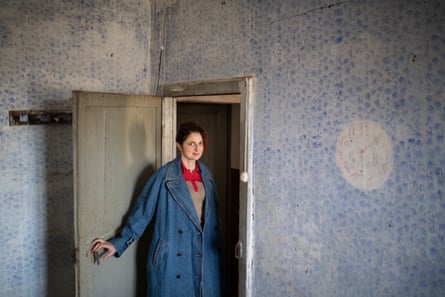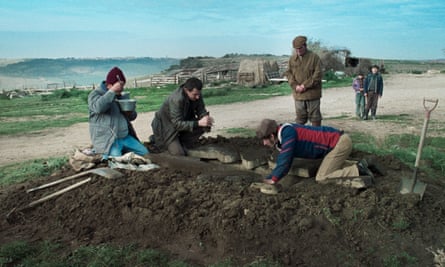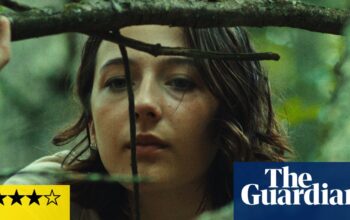Alice Rohrwacher could be the European arthouse made flesh, or its distilled essence, bottled and preserved for the ages. She’s quoting Italian poets one minute and German poets the next. She’s discussing nature, civilisation and the power of collective memory. She says she makes films to shake us from our lethargy and invite us to reflect on the state of the world. It doesn’t matter whether we even like her films. Like or dislike: that’s beside the point.
Certain criticisms she takes as compliments. “For example, people will tell me, ‘I always knew that I was watching a film.’ Well, good, that’s great. I am trying to break your hypnosis. Or people will say, ‘I struggled to get into this film.’ Which is fantastic, I’m pleased. We don’t need to get inside everything, break down every door, storm in like conquistadors. There are other ways to approach a film. We can gently knock. We can walk around it in circles.”
Her gorgeous new picture is about modern-day door-breakers, the conquistador mindset. Ostensibly, La Chimera plays as a crime caper, focusing on the antics of a gang of tomb-raiders – the tombaroli – in 1980s Italy. But this being Rohrwacher, the film is about more than just that. It’s about the living and the dead; the daylight realm and the underworld; history, property, politics, you name it.

“So yes, it’s not just a story of the tombaroli,” she says, vexed. “It’s the greater story of what happened in the hearts of man, about a change symbolised by this 1980s phenomenon that archeologists called La Grande Razzia, The Great Raid, which was a big treasure hunt of ancient Etruscan culture. Because for 2,000 years these sacred artefacts had remained intact. They were seen as sacred objects, not things to be sold. Then all of a sudden people started looting the tombs and temples. So the tombaroli were a local phenomenon. But on a wider level, they represent the moment where capitalism becomes a part of us all.”
Rohrwacher, 42, has beamed in from her house in Umbria, not far from where the film was shot. The place was once a working farmhouse, but it had lain abandoned for years before she moved in with her family. That’s common to the region, she says, it’s what happens all over. People live alongside the past, in the ruins of history. They tend to move between shells like hermit crabs.
La Chimera’s not a shell. It’s a treasure chest or a buried city; a film of fabulous layers and playful echoes. The British actor Josh O’Connor plays Arthur, the tombaroli’s lucky charm, dowsing for holes with the aid of a switch of witch-hazel. Arthur wants loot: he’s deep in debt to a fence. But he also wants to find Beniamina, his lost love, who might be dead or simply lying low. So he’s scouring the small towns and the big house on the hill. He’s searching the graves in the woods and the tombs near the beach. It’s as though his dowsing rod is a thread that somehow connects his hand to hers. “Yes,” Rohrwacher says. “Like the tale of Orpheus and Eurydice.”
The film-maker likes to think of her work as organic, naturally grown out of her own native soil. Except that this is only half the picture. Her father is German: her surname’s the giveaway. “So my own identity is complicated. On the one hand I feel very tied to my country, very loving of it; it’s where I’ve lived all my life. But I’m always perceived as a foreigner.”
She hunts for a reference. “[The Italian author] Elsa Morante says that a person who’s got mixed blood is like a robber who’s leaning against the treasure and wondering where it is. Or that they somehow shadow themselves, because they are both the thief and the treasure. I don’t know if that’s true of me, but maybe I try to combine those two gazes in my films. The intimate and the anthropological.”
Whatever she’s doing, it’s undeniably working. Rohrwacher’s approach bore fruit on her 2014 breakthrough, The Wonders, a lush coming-of-age tale, centred around her own family’s honey farm. It paid off most handsomely on 2018’s Happy As Lazzaro, a bumper harvest in the guise of a motion picture. Rohrwacher’s account of modern-day sharecroppers audaciously connected the past with the present, the countryside with the city. Her Italian side provided the film’s fine-grained closeups. Her German half, presumably, took care of the wide shots and kept a dispassionate eye on the ensemble cast.
after newsletter promotion
Ideally, her productions are community projects, folding local workers in amid the professional actors and technicians. Rohrwacher likens her process to conducting a choir but accepts that the singers aren’t always in harmony. “When I made Happy As Lazzaro, I was mainly working with the local farmers and they had other things to do. They had to keep going off to plough the fields and I had to try to explain that the film was just as important. They’d say, ‘Oh, I can’t come tomorrow, I’ve got work to do.’ And I’d say, ‘But you have to. This is work.’” She laughs. “But that’s good for me and it’s good for the film. It’s important to work with people who have other needs, other necessities. It helps me to see the true scale of the world.”
The world, for its part, has clutched her to its breast. Devotees of the director’s work include Greta Gerwig and Bong Joon-ho, Martin Scorsese and Sofia Coppola. As for the locals, they remain unconvinced. “Oh yes,” she says. “Unfortunately so. The people I work with locally, they find my films boring. I think I have earned their respect as a person. Hopefully one day I’ll earn it as a film-maker as well.”
The problem, she suspects, relates to what we were discussing earlier. It’s the cultural shift, it’s capitalism. It’s the presumption that cinema is by nature escapist. “People are now used to films that we consume like fast food. These people have been working hard all day, so they want to escape, to run away. They want to watch a film that makes them forget everything. Whereas I try to make films that make people remember, not forget.”

She was raised among bees, the daughter of a honey farmer, and thinks that this has made a difference. Bees, for one, are social animals. They have an innate understanding of history: the threads that connect the past, present and future. “So I owe so much to bees, to living and working with bees, because they developed my attention. And I don’t mean focusing on just one thing, but on everything. The organic process, the world.”
Rohrwacher says that bees are the poets of nature. This reminds her of another quote, this one from Rainer Maria Rilke, who described poets as “the bees of the invisible”. The poet’s role, Rilke wrote, is to collect the world’s nectar, its essence, and then “to store it in the great, golden hive of the invisible”.
Midway through La Chimera, the tombaroli hit the jackpot. A hole in the sand opens on to treasure. Below is a temple containing murals and votive offerings. This means that Arthur is saved on one level and possibly damned on another. Literally and metaphorically, our hero is travelling towards darkness.
Judged by modern standards, the Etruscan ethos is weird, she admits. Nowadays we can’t bake a cake without sticking it on Instagram. Why make something so beautiful only to bury it in the ground? All that love, labour, skill – and for what?
“But maybe there’s a lesson to be learned,” she says. “Not necessarily that we should hide what we create, but that we should try to preserve it as well as just showing it. That we should try to pass things on to the future, to be looked at by future eyes, future generations.”
Our time’s almost up, which feels oddly fitting. Rohrwacher says, “One of the things I loved about living in an area with such rich archaeological history, when I was little, was learning that civilisations always come to an end. It makes me think ours will end, too. And that makes me wonder what we’ll leave behind. Of course, I hope that one day, when future archeologists look back at our time, I won’t only have left a lot of trash, plastic and batteries. I hope I’ll have left some films behind, too.”
Source: theguardian.com


